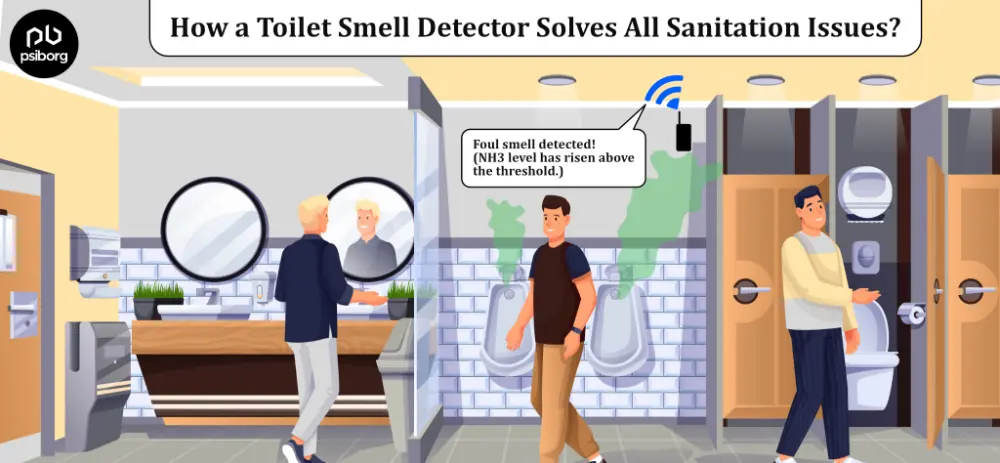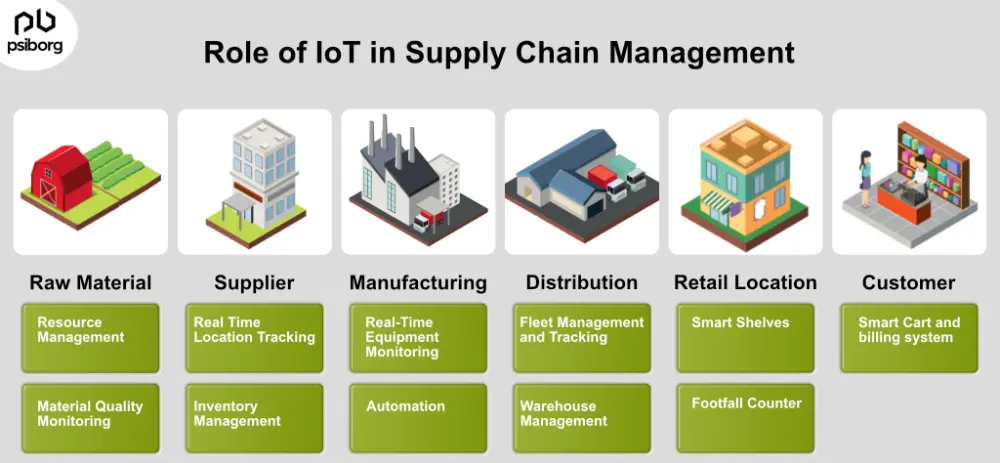WHAT IS THE TECHNOLOGY REQUIREMENT IN IOT?
Full-stack IoT development in itself is a set of technology stacks that includes the development of hardware, programming the hardware ( Embedded Firmware ), Connecting the devices with a communication protocol, and sending data to the central server with IoT data protocols, IoT App development, etc.
The Internet of Things (IoT) is the network of physical objects that have sensors, and are supported by software, and other technologies for connecting and exchanging data with other devices and systems over the internet/any other network such as Bluetooth, NBIoT, LTE, etc. Technology requirement in IoT Products involves a combination of different tech stacks required in the development of Hardware and Firmware, IoT application development, and IoT cloud integration, which in themselves requires knowledge of different elements.
IOT ARCHITECTURE
The fundamental architecture of IoT consists of four layers. Let’s understand how of IoT development Lifecycle works
- Data Gathering: This is the process of data input from the user’s end. The data entered is collected by the IoT application.
- Data Transmission: In this stage, the data is transmitted to the cloud or other storage servers through a connection of networks. This connection can be established using WiFi, GPRS, Ethernet, etc.
- Data Processing: In this layer of IoT, data stored at the server is processed to generate the desired output for the user.
- Application Layer: This layer functions as the management layer for an application which includes data storage and display.
Technology requirement in IoT product development is huge, as IoT is a combination of various technologies.
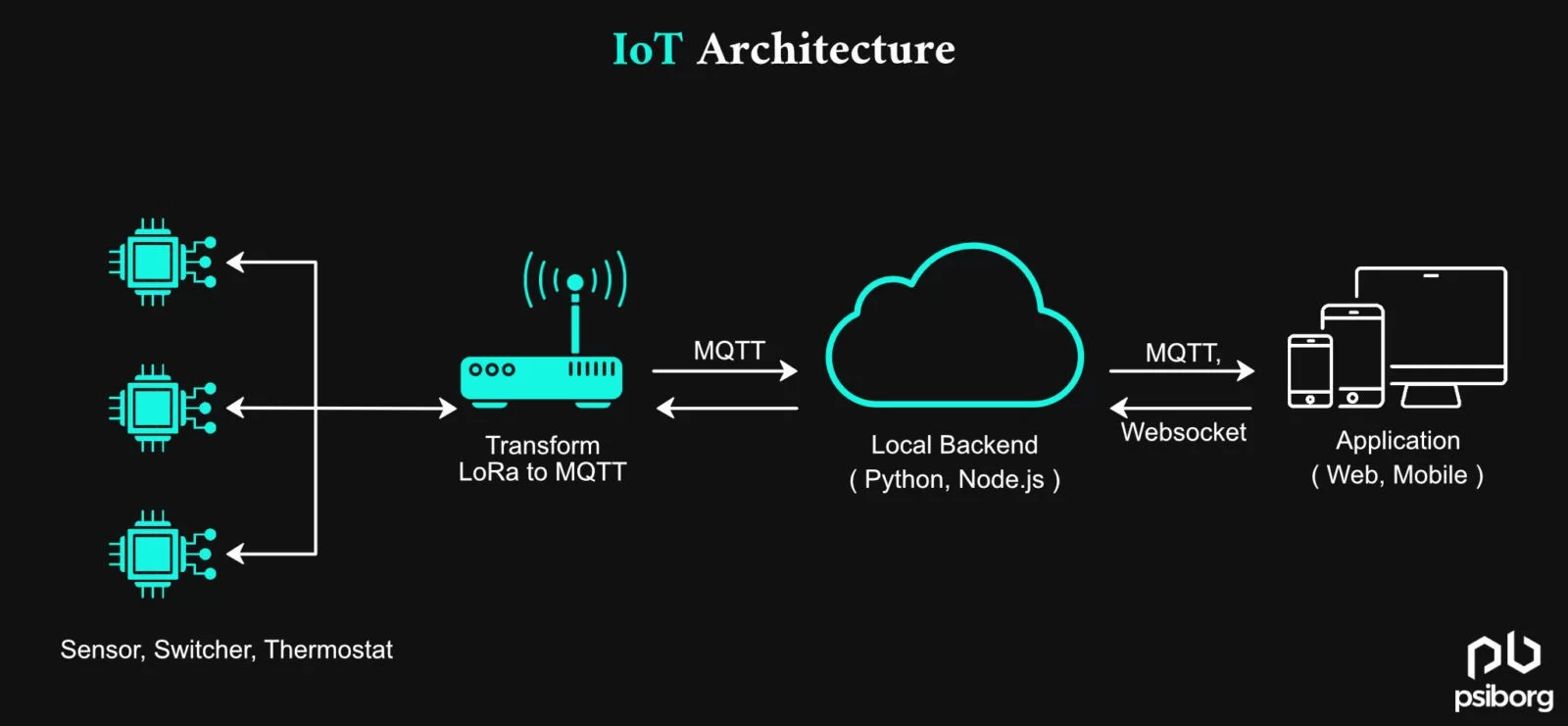
The data from the several sensor nodes installed in the monitored area is communicated to a central gateway. The communication protocols used in sending data to the IoT gateway are mostly Low Power Wide area network protocols such as LoRa. The IoT gateway has an internet access module embedded in it. This data is further sent to the server (using the internet) via MQTT / HTTP data protocols. This data from the Cloud server is fetched from Web / Mobile Applications Associated with the IoT solution.
THE IOT TECHNOLOGY STACK – TECHNOLOGY REQUIREMENTS IN IOT
The internet of things technology stack can prove a tough nut to crack if we try to find our way through this technological maze. This is because of the complexity of IoT technology and IoT device requirements. However, in this blog, we are going to simplify and attempt to break down the technological requirements of IoT into 5 basic technology layers involved in the Internet of Things product development. These are the following:
Things in IoT – IoT Device Hardware – The interaction between the physical and digital worlds is provided through IoT devices. They are the foundation of the Internet of Things technological stack. IoT Device hardware mostly consists of Microcontrollers, sensor-based devices, connectivity modules, and other peripherals. Firmware is the hardware code that helps the hardware to work for specific purposes. Fota in IoT devices is also becoming increasingly important as the number of IoT devices grows, to update and upgrade code remotely altogether.
Connectivity – IoT Communication protocol– The hardware in IoT enables communication with the Cloud or other local devices through Communication Protocols. Communication refers to the different methods through which the device exchanges information with the rest of the world. It is sometimes also referred to as connectivity. IoT communication Protocols help in communication between IoT devices and Cloud.
Edge Computing – Computing at IoT Gateway- When the IoT devices form a wireless sensor network , the data from various sensor nodes is sent to an edge gateway, where data is processed. This data can also be seen locally without the internet.
Data Analysis and Storage – IoT Cloud platforms – The edge-computed data is sent to the Cloud platform. The cloud platform provides the foundation for critical functions like data collecting, processing, and IoT data analytics.
Data Abstraction and Visualization – IoT Web/ mobile Application – These are end-user applications that serve the user interface for the IoT system. These applications will most likely be web-based IoT Application, and or mobile-based IoT application.
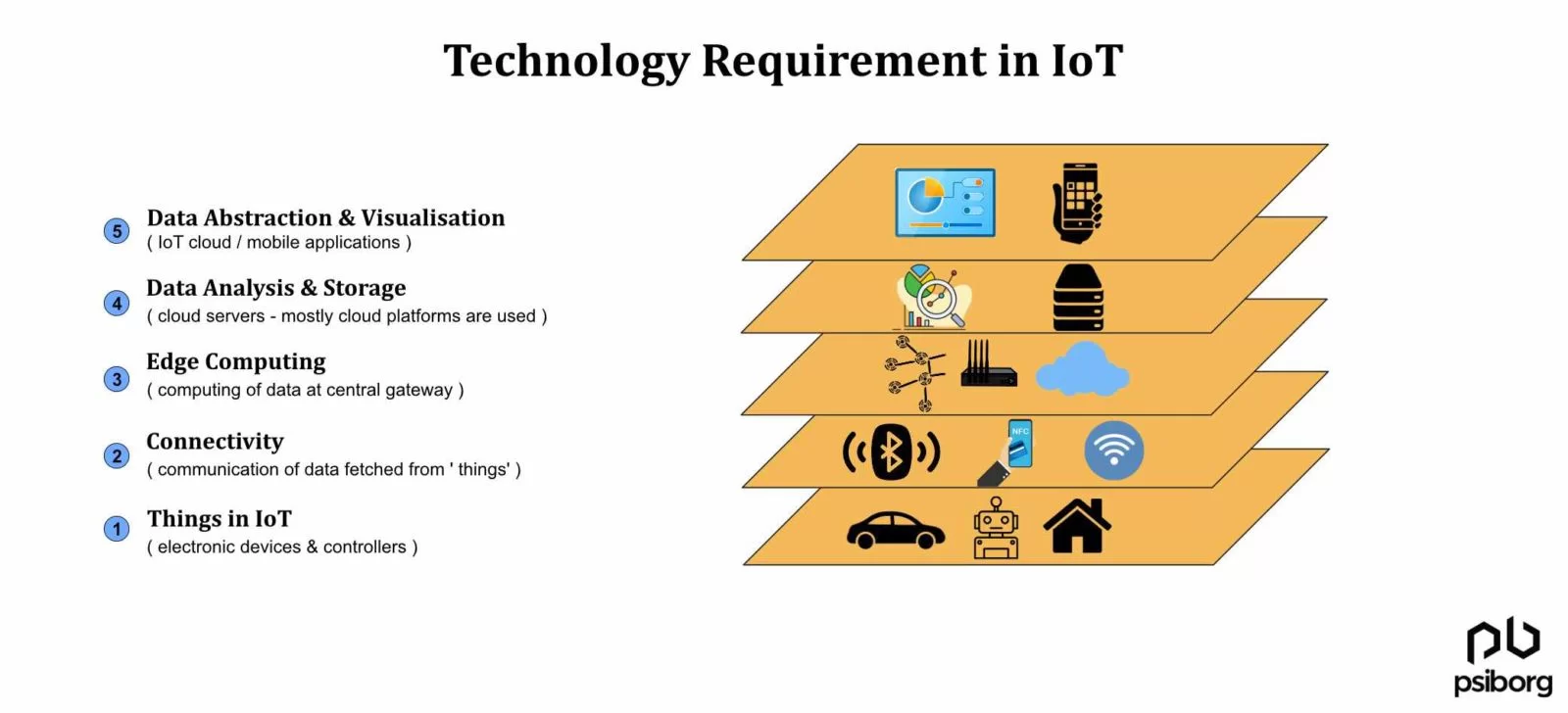
Here’s some more detail about technology requirement IoT solution development
IOT HARDWARE CONSIDERATIONS
An IoT device hardware is a printed circuit board (PCB) that has circuitry and hardware components designed to work with a specific microcontroller. Electronics prototyping is one of the initial steps of IoT hardware development.
Here’s a look at the important components of choosing an IoT hardware
- Power circuit– It enables the circuit with the power to run.
- Programming interface– It enables you to program the microcontroller from a computer.
- Basic input – These are usually buttons
- Basic output– These are usually LEDs
- I/O pins– For controlling motors, temperature sensors, LEDs, LCD screens, and other peripherals.
Key must-have features for all IoT boards:
- Processing power – A microcontroller is quite useful for programming the device as many manufacturers provide the IDE that you require.
- Wireless capabilities – It ensures wireless communication without an external transceiver module. Some of the most commonly used wireless technologies include Bluetooth, Zigbee, WiFi, and other LPWAN technologies.
- Scalability – With scalability, you can add more functionality to the board. You may want to cross-check if the board communicates via GPIO, UART, SPI, or some other protocol since this will decide how the board interacts with other devices.
- Memory – The storage capability depends on the board memory in hardware prominently. To store a lot of data, you need built-in Flash memory. Most IoT boards allow connecting a MiniSD or MicroSD card to increase data storage.
Examples of commonly used IoT Prototyping boards.
- RaspberryPi
- IntelEdison
- Particle
- Arduino
IoT Prototyping boards can only be used for PoC sometimes or are used by IoT enthusiasts. A marketable product is always developed with a Customized PCB.
Also Read: Common PCB Design Mistakes
HARDWARE CODE OR FIRMWARE
IoT Firmware development refers to the development of hardware code. The code in the hardware is quite vital to the functioning of the hardware’s operation. It interacts with the hardware’s electrical and electronic components. For updates in IoT hardware, FOTA should be supported.
Custom Embedded Firmware development requires expertise in programming the hardware along with compatibility with various other peripherals and devices.
IOT CLOUD PLATFORM
IoT cloud platforms leverage the power of IoT devices and cloud computing. In the IoT ecosystem, Edge computing has also been implemented widely. Edge computing and Cloud computing, both are used for processing data but at different places.
The market is replete with a number of robust cloud platforms provided by famous service providers. Here are the most commonly used cloud platforms:
- Google Cloud IoT
- Amazon AWS IoT Core
- Microsoft Azure IoT Hub
- IBM Bluemix IoT cloud
GOOGLE CLOUD IOT
It was launched by Google and is currently one of the world’s leading Internet of Things platforms. The integration of numerous services that add to the value of linked solutions is what is known as Google Cloud IoT. Some of these services are:
- Cloud IoT Core Cloud Pub/Sub
- Google BigQuery
- AI Platform
- Google Data Studio
AMAZON AWS IOT CORE
AWS IoT is the provider of cloud services that connect IoT devices to other devices and AWS cloud services. AWS IoT provides device software that can help in the integration of IoT devices into AWS IoT based solutions. If the devices can connect to AWS IoT, AWS IoT can connect them to the cloud services that AWS provides.
With AWS IoT, you can select the most appropriate and up-to-date technologies for your solution. AWS IoT Core supports these protocols for IoT services:
- MQTT (Message Queuing and Telemetry Transport)
- MQTT over WSS (WebSocket Secure)
- HTTPS (Hypertext Transfer Protocol – Secure)
Most IoT devices use MQTT as it can provide two-way communication.
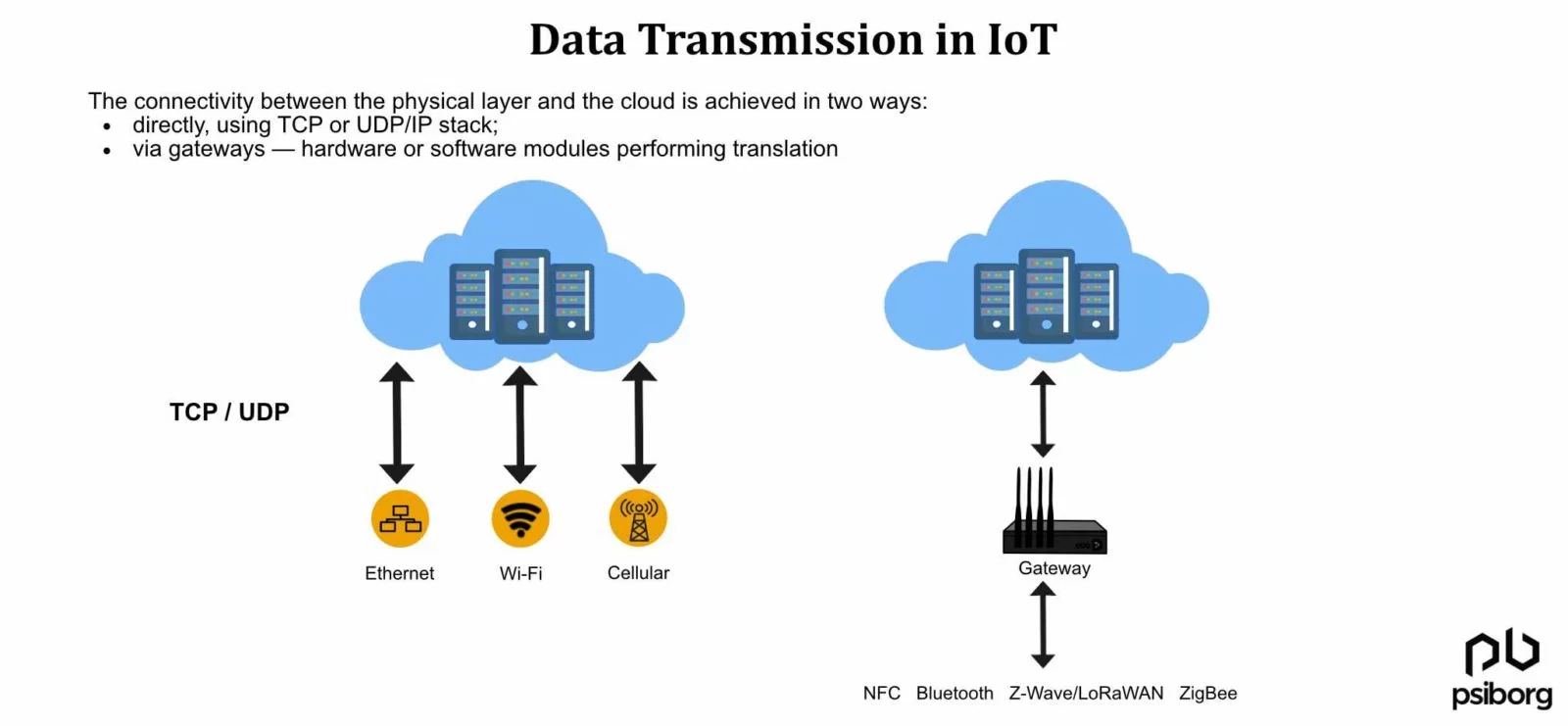
IOT COMMUNICATION PROTOCOLS
Choosing an IoT connectivity protocol totally depends on the technology requirement of IoT product to be developed.
BLE (BLUETOOTH LOW ENERGY)
It is commonly used for short-range communication. Bluetooth Low-Energy, a technology later introduced, has optimized power consumption. Small-scale consumer IoT applications such as fitness and medical wearables like oximeters, smartwatches, etc. work on BLE.
RFID
RFID stands for Radio Frequency Identification (RFID). This technology makes use of radio signals to transmit small amounts of data from an RFID tag to a reader located within a very short distance. Till now, technology has facilitated a major revolution in retail and logistics.
RFID technology is simple to use. By simply putting an RFID tag on different products and equipment, businesses can track their inventory and assets in real-time – allowing for better stock and production planning as well as optimized supply chain management.
WI-FI
Connectivity in IoT solutions requires the internet. The Internet is provided either through WiFi or cellular Networks. However, in the IoT space, its major limitations in coverage, scalability, and power consumption make the technology much less prevalent.
Due to high energy requirements, Wi-Fi is often not a preferred solution for large networks of battery-operated IoT sensors, especially in industrial IoT settings. WIFI is most suitable to use in the cases where the IoT device is connected to power outlets. Examples include smart home gadgets and appliances, digital signages, etc.
With the increase in IoT devices, the IoT requirements for Low Power networks arose.
LPWAN – LOW POWER WIDE AREA NETWORK
LPWAN technology is a relatively new phenomenon in IoT. It provides long-range communication by using small, inexpensive batteries that have a long life. Large-scale IoT networks spread over vast industrial and commercial campuses are the places where LPWAN is prominently used.
Some LPWA networks which require gateways as a bridge are-
- LoRa-based IoT networks
- Sigfox-based IoT networks
- Zigbee-based IoT Solution
- Sub-1 GHz based IoT network
The most popular cellular connectivity protocols which connect IoT devices to the internet are:-
- NBIoT-based IoT solution
- LTE- M-based IoT solution
- GSM or 2G
- LTE – 4G
Choosing between LTE – M and NBIoT is totally dependent on the application.
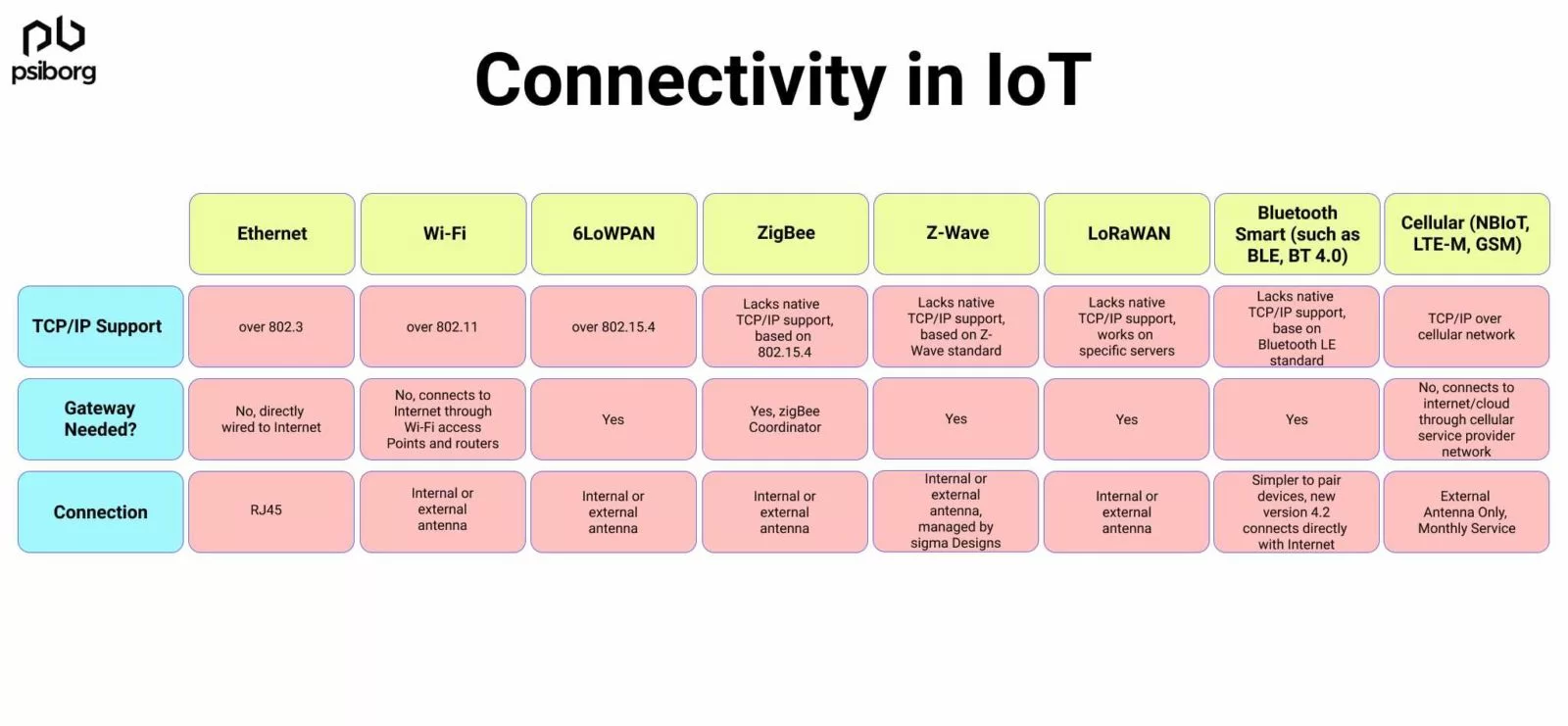
IOT DATA PROTOCOLS
IoT protocols are an integral part of IoT technology product development. Without IoT data protocols, there would be no transferring data to the server. And, out of these transferred pieces of data, the user extracts useful information.
Some IoT data protocols are:-
- MQTT
- HTTP
IOT APPLICATIONS
IoT applications are the end-user interfaces that run and control IoT devices. These are tailor-made for specific industries and verticals, such as healthcare, industrial automation, smart homes and buildings, automotive, smart wearable technology, etc. Today, IoT applications are using AI and machine learning to add intelligence to devices.
Developers make use of various frameworks for IoT app development. These are:
- Ionic APP development
- Flutter app development
- React native app development
FUTURE POSSIBILITIES OF TECHNOLOGY REQUIREMENT IN IOT
Major challenges in IoT technologies include security, high cost, and data privacy.
Another critical issue in IoT technologies is the issue of data privacy. Since IoT involves personal data (e.g. fitness and training devices), so there is an associated risk of data getting leaked due to network security issues or malicious hackers. The last challenge concerns the high cost of IoT technologies.
Crafting an IoT ecosystem in a way that can bring down the cost of key IoT technologies for wider and deeper penetration of IoT is one of the challenges already worked upon.
PsiBorg , an IoT solutions company , specializes in crafting customized IoT solutions that leverage these latest technologies to suit your requirements.



